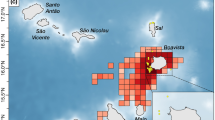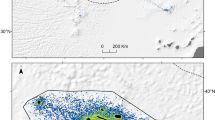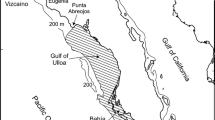Abstract
Oceanic manta rays Mobula birostris are declining globally due to fisheries. Past work has shown that movements and distributions of oceanic manta ray populations are sensitive to climatic fluctuations such as the El Niño Southern Oscillation. The Revillagigedo National Park (RNP), Mexico, is a well-known aggregation site for oceanic manta rays. However, published baseline data on population structure and dynamics, and the influence of oceanographic variables on the abundance of oceanic manta rays in the region are lacking. We used 2015–2019 photo-identification data to describe baseline demographic characteristics of this population and to evaluate the influence of environmental factors on population dynamics. A significant sex bias was found with a female:male ratio of 1.4:1. Mark-recapture (MR) was used to estimate monthly abundance and provided the first superpopulation size estimate of 1172 (± 90), representing all individuals using the RNP during the survey period. The MR analysis suggests a significant relationship between the multivariate ENSO index and monthly survival probabilities, and chlorophyll-a as a driver of recruitment in surveyed dive sites. These findings provide a baseline to support effective conservation and management plans for this endangered species in the Mexican Pacific.



Similar content being viewed by others
Data availability
The data generated and/or analyzed during this study are included in this published article [Supplementary Information.pdf] and in the GitHub repository, [https://github.com/MadalenaCabral/Rcode-for-MarkRecap-analysis.git].
References
Aldana-Moreno, A., E. M. Hoyos-Padilla, R. González-Armas, F. Galván-Magaña, A. Hearn, A. P. Klimley, W. Winram, E. E. Becerril-García & J. T. Ketchum, 2020. Residency and diel movement patterns of the endangered scalloped hammerhead Sphyrna lewini in the Revillagigedo National Park. Journal of Fish Biology 96: 543–548.
Andrzejaczek, S., R. J. Schallert, K. Forsberg, N. S. Arnoldi, M. Cabanillas-Torpoco, W. Purizaca & B. A. Block, 2021. Reverse diel vertical movements of oceanic manta rays off the northern coast of Peru and implications for conservation. Ecological Solutions and Evidence. https://doi.org/10.1002/2688-8319.12051.
Araujo, G., A. R. Ismail, C. McCann, D. McCann, C. G. Legaspi, S. Snow, J. Labaja, M. Manjaji-Matsumoto & A. Ponzo, 2020. Getting the most out of citizen science for endangered species such as whale shark. Journal of Fish Biology 96: 864–867. https://doi.org/10.1111/jfb.14254.
Armstrong, A. O., G. M. W. Stevens, K. A. Townsend, A. Murray, M. B. Bennett, A. J. Armstrong, J. Uribe-Palomino, P. Hosegood, C. L. Dudgeon & A. J. Richardson, 2021. Reef manta rays forage on tidally driven, high density zooplankton patches in Hanifaru Bay, Maldives. PeerJ 9: e11992.
Barr, Y. & A. Abelson, 2019. Feeding—cleaning trade-off: Manta ray “decision-making” as a conservation tool. Frontiers in Marine Science. https://doi.org/10.3389/fmars.2019.00088/full.
Beale, C. S., J. D. Stewart, E. Setyawan, A. B. Sianipar & M. V. Erdmann, 2019. Population dynamics of oceanic manta rays (Mobula birostris) in the Raja Ampat Archipelago, West Papua, Indonesia, and the impacts of the El Niño-Southern Oscillation on their movement ecology. Diversity & Distributions 25: 1472–1487.
Becerril-García, E. E., M. A. Gutiérrez-Ortiz, P. A. Preciado-González & A. Ayala-Bocos, 2019. Presence of Remora remora on Mobula birostris in Revillagigedo National Park, Mexico. Marine and Freshwater Research 71: 414–417.
Braun, C. D., G. B. Skomal, S. R. Thorrold & M. L. Berumen, 2015. Movements of the reef manta ray (Manta alfredi) in the Red Sea using satellite and acoustic telemetry. Marine Biology 162: 2351–2362. https://doi.org/10.1007/s00227-015-2760-3.
Burnham, K. P. & D. R. Anderson, 2004. Multimodel Inference. Sociological Methods & Research. https://doi.org/10.1177/0049124104268644.
Cailliet, G. M., M. S. Love, & A. W. Ebeling, 1996. Fishes: A Field and Laboratory Manual on Their Structure, Identification, and Natural History. Waveland Press, https://play.google.com/store/books/details?id=mHUWAQAAIAAJ.
Carter, A. L., A. M. W. Wilson, M. Bello, E. M. Hoyos-Padilla, M. E. Inall, J. T. Ketchum, A. Schurer & A. W. Tudhope, 2020. Assessing opportunities to support coral reef climate change refugia in MPAs: a case study at the Revillagigedo Archipelago. Marine Policy 112: 103769.
Couturier, L. I. E., C. L. Dudgeon, K. H. Pollock, F. R. A. Jaine, M. B. Bennett, K. A. Townsend, S. J. Weeks & A. J. Richardson, 2014. Population dynamics of the reef manta ray Manta alfredi in eastern Australia. Coral Reefs 33: 329–342. https://doi.org/10.1007/s00338-014-1126-5.
Dickinson, J. L., B. Zuckerberg & D. N. Bonter, 2010. Citizen science as an ecological research tool: challenges and benefits. Annual Review of Ecology, Evolution, and Systematics Annual Reviews 41: 149–172. https://doi.org/10.1146/annurev-ecolsys-102209-144636.
Dulvy, N. K., S. A. Pardo, C. A. Simpfendorfer & J. K. Carlson, 2014. Diagnosing the dangerous demography of manta rays using life history theory. PeerJ 2: 400. https://doi.org/10.7717/peerj.400.
Félix, F., C. Castro, & J. L. Laake, 2020. Abundance and survival estimates of the southeastern Pacific humpback whale stock from 1991–2006 photo-identification surveys in Ecuador. The journal of cetacean research and management International Whaling Commission 301–307, https://journal.iwc.int/index.php/jcrm/article/view/303.
Fernando, D. & J. D. Stewart, 2021. High bycatch rates of manta and devil rays in the “small-scale” artisanal fisheries of Sri Lanka. PeerJ 9: e11994.
Fiedler, P. C., 2002. Environmental change in the eastern tropical Pacific Ocean: review of ENSO and decadal variability. Marine Ecology Progress Series 244: 265–283.
Fourriére, M., H. Reyes-Bonilla, C. M. Galván-Villa, A. Ayala Bocos & F. Alejandro Rodríguez-Zaragoza, 2019. Reef fish structure assemblages in oceanic islands of the eastern tropical Pacific: Revillagigedo Archipelago and Clipperton atoll. Marine Ecology 40: e12539. https://doi.org/10.1111/maec.12539.
Gimenez, O., J.-D. Lebreton, R. Choquet & R. Pradel, 2018. R2ucare: An r package to perform goodness-of-fit tests for capture–recapture models. Methods in Ecology and Evolution/British Ecological Society 9: 1749–1754.
Gómez-Ocampo, E., G. Gaxiola-Castro, R. Durazo & E. Beier, 2018. Effects of the 2013–2016 warm anomalies on the California Current phytoplankton. Deep-sea research. Part II. Topical Studies in Oceanography 151: 64–76.
Graham, R. T., M. J. Witt, D. W. Castellanos & F. Remolina, 2012. Satellite tracking of manta rays highlights challenges to their conservation. PLoS ONE. https://doi.org/10.1371/journal.pone.0036834.
Grosbois, V., O. Gimenez, J. M. Gaillard, R. Pradel, C. Barbraud, J. Clobert, A. P. Møller & H. Weimerskirch, 2008. Assessing the impact of climate variation on survival in vertebrate populations. Biological Reviews of the Cambridge Philosophical Society 83: 357–399. https://doi.org/10.1111/j.1469-185X.2008.00047.x.
Hanski, I., 1999. Metapopulation Ecology, OUP, Oxford:
Jolly, G. M., 1965. Explicit estimates from mark-recapture data with both death and immigration-stochastic models. Biometrika 52: 225–247.
Ketchum, J. & H. Reyes-Bonilla, 2001. Taxonomía y distribución de los corales hermatípicos (Scleractinia) del Archipiélago de Revillagigedo, México. Revista De Biología Tropical 49: 803–848.
Ketchum, J. T., M. Hoyos-Padilla, A. Aldana-Moreno, K. Ayres, F. Galván-Magaña, A. Hearn, F. Lara-Lizardi, G. Muntaner-López, M. Grau, A. Trejo-Ramírez, D. A. Whitehead & A. P. Klimley, 2020. Shark movement patterns in the Mexican Pacific: a conservation and management perspective. Advances in Marine Biology 85: 1–37. https://doi.org/10.1016/bs.amb.2020.03.002.
L’Heureux, M. L., K. Takahashi, A. B. Watkins, A. G. Barnston, E. J. Becker, T. E. Di Liberto, F. Gamble, J. Gottschalck, M. S. Halpert, B. Huang, K. Mosquera-Vásquez & A. T. Wittenberg, 2017. Observing and predicting the 2015/16 El Niño. Bulletin of the American Meteorological Society American Meteorological Society 98: 1363–1382.
Lavín, M. F., P. C. Fiedler, J. A. Amador, L. T. Ballance, J. Färber-Lorda & A. M. Mestas-Nuñez, 2006. A review of eastern tropical Pacific oceanography: summary. Progress in Oceanography. https://doi.org/10.1016/j.pocean.2006.03.005.
Marshall, A. D., L. J. V. Compagno & M. B. Bennett, 2009. Redescription of the genus Manta with resurrection of Manta alfredi (Krefft, 1868) (Chondrichthyes; Myliobatoidei; Mobulidae). Zootaxa. https://doi.org/10.11646/zootaxa.2301.1.1.
Marshall, A. D., C. L. Dudgeon & M. B. Bennett, 2011. Size and structure of a photographically identified population of manta rays Manta alfredi in southern Mozambique. Marine Biology 158: 1111–1124. https://doi.org/10.1007/s00227-011-1634-6.
Marshall, A. D. & S. J. Pierce, 2012. The use and abuse of photographic identification in sharks and rays. Journal of Fish Biology 80: 1361–1379. https://doi.org/10.1111/j.1095-8649.2012.03244.x.
Marshall A, Bennett MB, Kodja G, Hinojosa-Alvarez S, Galvan-Magana F, Harding M, Stevens G, Kashiwagi T, 2020. IUCN Red List of Threatened Species, Manta birostris. Available at www.iucnredlist.org. Consulted on 30 July 2021
Mendelssohn, R., 2017. Rerddapxtracto: Extracts Environmental Data from ERD’s ERDDAP Web Service. R Package Version 0.3. 5.900.
Michael, S. W., 1993. Reef Sharks and Rays of the World: A Guide to Their Identification, Behavior, and Ecology, Sea Challengers, Monterey, CA:
Murie, C., M. Spencer & S. P. Oliver, 2020. Current strength, temperature, and bodyscape modulate cleaning services for giant manta rays. Marine Biology 167: 54. https://doi.org/10.1007/s00227-020-3674-2.
Ogburn, M. B., A.-L. Harrison, F. G. Whoriskey, S. J. Cooke, J. E. Mills Flemming & L. G. Torres, 2017. Addressing challenges in the application of animal movement ecology to aquatic conservation and management. Frontiers in Marine Science 4: 70.
Pradel, R., J. E. Hines, J.-D. Lebreton & J. D. Nichols, 1997. Capture-recapture survival models taking account of transients. Biometrics [Wiley, International Biometric Society] 53: 60–72.
Prieto, R., M. Tobeña & M. A. Silva, 2017. Habitat preferences of baleen whales in a mid-latitude habitat. Deep-sea research. Part II. Topical Studies in Oceanography 141: 155–167.
Rohner, C. A., S. J. Pierce, A. D. Marshall, S. J. Weeks, M. B. Bennett & A. J. Richardson, 2013. Trends in sightings and environmental influences on a coastal aggregation of manta rays and whale sharks. Marine Ecology Progress Series Inter-Research Science Center 482: 153–168.
Salomón-Aguilar, C. A., 2015. Zonas prioritarias de conservación de rayas y mantarrayas en el noroeste del Pacífico mexicano. Ciencia pesquera 23: 77–99, http://www.inapesca.gob.mx/portal/documentos/publicaciones/cienciapesquera/CP23-2/7-Salomon-2015.pdf.
Schwarz, C. J. & A. N. Arnason, 1996. A General Methodology for the analysis of capture-recapture experiments in open populations. Biometrics [Wiley, International Biometric Society] 52: 860–873.
Seber, G. A. F., 1970. Estimating time-specific survival and reporting rates for adult birds from band returns. Biometrika 57: 313–318.
Siders, Z. A., A. J. Westgate, D. W. Johnston, L. D. Murison & H. N. Koopman, 2013. Seasonal variation in the spatial distribution of basking sharks (Cetorhinus maximus) in the lower Bay of Fundy, Canada. PLoS ONE 8: e82074. https://doi.org/10.1371/journal.pone.0082074.
Stewart, J. D., C. S. Beale, D. Fernando, A. B. Sianipar, R. S. Burton, B. X. Semmens & O. Aburto-Oropeza, 2016a. Spatial ecology and conservation of Manta birostris in the Indo-Pacific. Biological Conservation 200: 178–183.
Stewart, J. D., E. M. Hoyos-Padilla, K. R. Kumli & R. D. Rubin, 2016b. Deep-water feeding and behavioral plasticity in Manta birostris revealed by archival tags and submersible observations. Zoology 119: 406–413. https://doi.org/10.1016/j.zool.2016.05.010.
Stewart, J. D., F. R. A. Jaine, A. J. Armstrong, A. O. Armstrong, M. B. Bennett, K. B. Burgess, L. I. E. Couturier, D. A. Croll, M. R. Cronin, M. H. Deakos, C. L. Dudgeon, D. Fernando, N. Froman, E. S. Germanov, M. A. Hall, S. Hinojosa-Alvarez, J. E. Hosegood, T. Kashiwagi, B. J. L. Laglbauer, N. Lezama-Ochoa, A. D. Marshall, F. McGregor, G. N. di Sciara, M. D. Palacios, L. R. Peel, A. J. Richardson, R. D. Rubin, K. A. Townsend, S. K. Venables & G. M. W. Stevens, 2018. Research priorities to support effective manta and devil ray conservation. Frontiers in Marine Science. https://doi.org/10.3389/fmars.2018.00314.
Thorson, J. T., M. D. Scheuerell, B. X. Semmens & C. V. Pattengill-Semmens, 2014. Demographic modeling of citizen science data informs habitat preferences and population dynamics of recovering fishes. Ecology Wiley 95: 3251–3258.
Venables, S. K., A. D. Marshall, E. S. Germanov, R. J. Y. Perryman, R. F. Tapilatu, I. G. Hendrawan, A. L. Flam, M. van Keulen, J. L. Tomkins & W. J. Kennington, 2019. It’s not all black and white: investigating colour polymorphism in manta rays across Indo-Pacific populations. Proceedings. Biological sciences/The Royal Society 286: 20191879. https://doi.org/10.1098/rspb.2019.1879.
Wang, C. & P. C. Fiedler, 2006. ENSO variability and the eastern tropical Pacific: a review. Progress in Oceanography 69: 239–266.
Ward-Paige, C. A., B. Davis & B. Worm, 2013. Global population trends and human use patterns of Manta and Mobula rays. PLoS ONE 8: e74835. https://doi.org/10.1371/journal.pone.0074835.
White, G. C. & K. P. Burnham, 1999. Program MARK: survival estimation from populations of marked animals. Bird Study: The Journal of the British Trust for Ornithology 46: S120–S139. https://doi.org/10.1080/00063659909477239.
White, W. T., J. Giles, Dharmadi, & I. C. Potter, 2006. Data on the bycatch fishery and reproductive biology of mobulid rays (Myliobatiformes) in Indonesia. Fisheries Research 82: 65–73
Williamson, M. J., E. J. Tebbs, T. P. Dawson & D. M. P. Jacoby, 2019. Satellite remote sensing in shark and ray ecology, conservation and management. Frontiers in Marine Science 6: 135.
Wilson, S. G., J. G. Taylor & A. F. Pearce, 2001. The Seasonal Aggregation of Whale Sharks at Ningaloo Reef, Western Australia: Currents, Migrations and the El Niño/ Southern Oscillation. Environmental Biology of Fishes 61: 1–11. https://doi.org/10.1023/A:1011069914753.
Wolter, K. & M. S. Timlin, 2011. El Niño/Southern Oscillation behaviour since 1871 as diagnosed in an extended multivariate ENSO index (MEI.ext). International Journal of Climatology. https://doi.org/10.1002/joc.2336.
Acknowledgements
We would like to thank Nautilus Liveaboards, Cantamar Liveaboards, and Mexico Liveaboards for field support. Our appreciation is also extended to all the citizen scientists who contributed photographs for the database. Carolina Segurado Marques provided support with R code. Two anonymous reviewers provided helpful comments that improved the manuscript. Funding for this research was provided by CONACYT Mexico (National Council for Science and Technology) through a PhD scholarship to M. Cabral (Grant number 762908).
Funding
Funding for this research was provided by CONACYT Mexico (National Council for Science and Technology) through a PhD scholarship to Madalena Mesquitela Cabral (Grant number 762908).
Author information
Authors and Affiliations
Contributions
Study conception and design by MMPC, HR-B, and TAM. Data collection and compilation by AAB. Data analysis was performed by MMPC, TAM, and JDS. Interpretation of data by MMPC, JDS, JTK, and EMH-P. The first draft of the manuscript was written by MMPC and all authors contributed to the revision of previous versions of the manuscript. All authors read and approved the final manuscript.
Corresponding author
Ethics declarations
Conflict of interest
The author(s)certify that there is no conflict of interest with any financial/research/academic organization, with regards to the content/research work discussed in the manuscript. The authors declare that they have no conflicts of interests.
Ethical approval
This study was carried out in accordance with CONAMP Mexico (National Commission of Natural Protected Areas) guidelines. No animal was constrained and the methods employed were non-invasive in nature.
Additional information
Handling editor: Grazia Pennino
Publisher's Note
Springer Nature remains neutral with regard to jurisdictional claims in published maps and institutional affiliations.
Supplementary Information
Below is the link to the electronic supplementary material.
Rights and permissions
Springer Nature or its licensor (e.g. a society or other partner) holds exclusive rights to this article under a publishing agreement with the author(s) or other rightsholder(s); author self-archiving of the accepted manuscript version of this article is solely governed by the terms of such publishing agreement and applicable law.
About this article
Cite this article
Cabral, M.M.P., Stewart, J.D., Marques, T.A. et al. The influence of El Niño Southern Oscillation on the population dynamics of oceanic manta rays in the Mexican Pacific. Hydrobiologia 850, 257–267 (2023). https://doi.org/10.1007/s10750-022-05047-9
Received:
Revised:
Accepted:
Published:
Issue Date:
DOI: https://doi.org/10.1007/s10750-022-05047-9




